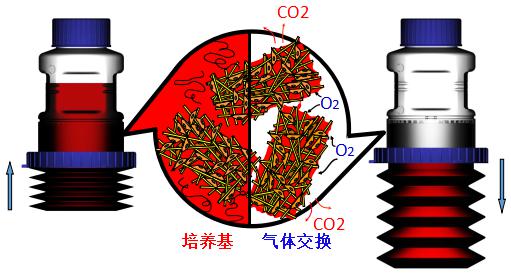一、什么是CelCradleTM生物反应器
CelCradleTM生物反应器根据潮汐涨落原理设计而成,其中波纹管的压缩和解压可使细胞不断接触培养基的营养与空气,提供了一个低细胞撕裂、无泡沫、高氧气饱和度以及高营养浓度的细胞培养环境。
CelCradleTM是用于高密度细胞培养的一款易于使用的经济型台式生物反应器,既可以高密度培养细胞,也可以收集细胞分泌产物。
二、CelCradleTM潮汐式工作原理
通过CelCradleTM细胞培养瓶底部的波纹管压缩和解压,细胞间歇的暴露在空气和培养基中,使细胞充分与培养基和氧气接触,和滚瓶的原理类似。
三、CelCradleTM生物反应器产品特点
•大面积高密度贴壁细胞培养空间
•预先灭菌、随时可用
•一次性使用CelCradleTM培养瓶,操作简单
•低剪切力、低细胞撕裂、无泡沫以及无氧气限制高营养的细胞培养环境
•兼容大多数无血清培养基
•全细胞、细胞组分或细胞产物的培养和采集功能
四、为什么选择CelCradleTM生物反应器
1. 简便易用的设计,一次性使用可以节约空间和人力资源
CelCradleTM生物反应器是一款随时可用的一次性生物反应系统,无需启动时间及复杂的学习过程.
CelCradleTM生物反应器可放置在6立方英尺CO2培养箱内,并且可同时运行4个细胞培养瓶。 一个标准CelCradleTM细胞培养瓶带有5.5g BioNoc II载体,可提供15000平方厘米的细胞培养总面积,培养细胞数可达到4~5 x 109/瓶,相当于18至20个滚动式细胞培养瓶的培养量。
可以通过增加CelCradleTM培养瓶数或者使用同为潮汐原理的TideCellTM生物反应器实现细胞规模的扩大化生产,从而简化了培养系统规模扩大的过程以及节省了开发过程中所需的支出。
2. 高细胞产量,特殊的B_H功能促进蛋白表达
一台CelCradleTM生物反应器可取代数百个培养皿、传统细胞培养瓶以及多组细胞培养滚瓶等等,从而大大缩减生产成本。

该系统不仅可实现较高的细胞产量,且这种特殊的B_H功能(增加底部保持时间)不仅限制了细胞的过度生长而且增加了超过3倍的蛋白表达,同时还可实现更高的蛋白浓度并在培养过程中节省培养基。
五、应用领域
•哺乳动物和昆虫细胞培养
•蛋白质和病毒生产
•单克隆抗体生产
•蛋白质组研究
•药物研发
•药物代谢动力学研究
•基因和细胞治疗研究
专业论文支持
以下是一些现有支持CelCradleTM细胞培养系统的科学研究应用的学术论文
[1]Akiyama, M., Nakayama, D., Takeda, S., Kokame, K., Takagi, J., & Miyata, T. (n.d.). Crystal structure and enzymatic activity of an ADAMTS-13 mutant with the East Asian-specific P475S polymorphism. J Thromb Haemost Journal of Thrombosis and Haemostasis, 1399-1406.
[2]Asaoka, Y., Tanaka, T., Tsumoto, K., Tomita, M., & Ide, T. (n.d.). Efficient expression of recombinant soluble human FcγRI in mammalian cells and its characterization. Protein Expression and Purification, 155-161.
[3]Brown, A., Mcsharry, J., Adams, J., Kulawy, R., Barnard, R., Newhard, W., . . . Drusano, G. (2011). Pharmacodynamic Analysis of a Serine Protease Inhibitor, MK-4519, against Hepatitis C Virus Using a Novel In Vitro Pharmacodynamic System. Antimicrobial Agents and Chemotherapy, 1170-1181.
[4]Chen, Y., Wu, J., Wang, K., Chiang, Y., Lai, C., Chung, Y., & Hu, Y. (n.d.). Baculovirus-mediated production of HDV-like particles in BHK cells using a novel oscillating bioreactor. Journal of Biotechnology, 135-147.
[5]Drugmand, J., J.-F., J., Agathos, S., & Schneider, Y. (n.d.). Growth of Mammalian and Lepidopteran Cells on BioNOC® II Disks, a Novel Macroporous Microcarrier. Cell Technology for Cell Products, 781-784.
[6]Hammonds, J., Chen, X., Zhang, X., Lee, F., & Spearman, P. (n.d.). Advances in methods for the production, purification, and characterization of HIV-1 Gag–Env pseudovirion vaccines. Vaccine, 8036-8048.
[7]Haredy, A., Takenaka, N., Yamada, H., Sakoda, Y., Okamatsu, M., Yamamoto, N., . . . Okamoto, S. (2013). An MDCK Cell Culture-Derived Formalin-Inactivated Influenza Virus Whole-Virion Vaccine from an Influenza Virus Library Confers Cross-Protective Immunity by Intranasal Administration in Mice. Clinical and Vaccine Immunology, 998-1007.
[8]Haredy, A., Yamada, H., Sakoda, Y., Okamatsu, M., Yamamoto, N., Omasa, T., . . . Yamanishi, K. (2014). Neuraminidase gene homology contributes to the protective activity of influenza vaccines prepared from the influenza virus library. Journal of General Virology, 2365-2371.
[9]Ho, L., Greene, C., Schmidt, A., & Huang, L. (n.d.). Cultivation of HEK 293 cell line and production of a member of the superfamily of G-protein coupled receptors for drug discovery applications using a highly efficient novel bioreactor. Cytotechnology, 117-123.
[10]Hu, Y., Lu, J., & Chung, Y. (n.d.). High-density cultivation of insect cells and production of recombinant baculovirus using a novel oscillating bioreactor. Cytotechnology, 145-153.